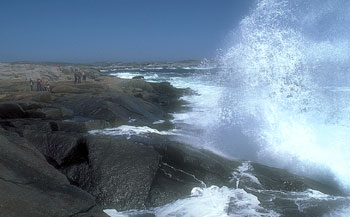| ||||||||||||||||||||||||||||
Proactive disclosure Print version |  Climate Change Impacts and Adaptation: A Canadian Perspective Coastal Zone
The coastal zone forms a dynamic interface of land and water of high ecological diversity and critical economic importance. Natural features in the coastal zone support a diverse range of species and are key areas for fisheries and recreation, while coastal infrastructure is essential for trade, transportation and tourism. Canada's coastline, which is the longest in the world, extends along the Atlantic, Pacific and Arctic Oceans, as well as along the shores of large freshwater bodies, such as the Great Lakes. Climate change would impact the coastal zone primarily through changes in water levels. Sea level rise, resulting from thermal expansion of ocean waters and increased melting of glaciers and ice caps, is the main issue for marine regions. Conversely, declining water levels, resulting from changes in precipitation and evaporation, are projected for the Great Lakes. Other impacts on the coastal zone would result from changes in wave patterns, storm surges, and the duration and thickness of seasonal ice cover. Global sea level is projected to rise by 8 to 88 centimetres between 1990 and 2100, with sea level rise continuing and perhaps accelerating in the following century. From an impacts and adaptation perspective, however, it is relative sea level rise that is important. Changes in relative sea level would vary regionally and depend largely on geological processes. Overall, more than 7000 kilometres of Canada's coastline are considered highly sensitive to future sea level rise. In these sensitive regions, sea level rise and climate change are expected to lead to a suite of biophysical and socio-economic impacts (Figure 6). Figure 6: Potential biophysical and socio-economic impacts of climate change in the coastal zone.
Many regions along the Atlantic coast are identified as highly sensitive to sea level rise. These include the north shore of Prince Edward Island, the Gulf coast of New Brunswick, much of the Atlantic coast of Nova Scotia, and parts of Charlottetown and Saint John. Key issues for these areas include increases in storm surge flooding, permanent submerging of parts of the coast, accelerated erosion of beaches and coastal dunes, degradation of coastal wetlands such as salt marshes and saltwater intrusion into coastal aquifers. A case study conducted in Prince Edward Island suggests that more intense storm surges resulting from sea level rise and climate change would have significant economic impacts on urban infrastructure and properties in Charlottetown. Although the Pacific region has a generally low sensitivity to sea level rise, there are small but important areas, including parts of the Queen Charlotte Islands, the Fraser Delta, and portions of Victoria and Vancouver, that are considered highly sensitive. Main issues include the breeching of dykes, flooding and coastal erosion. The Fraser Delta, which supports a large and rapidly growing population, is protected by an extensive dyke system, and parts of the delta are already below sea level. Further sea level rise in this region would impact natural ecosystems, farmland and industrial and residential areas in the region, unless accompanied by appropriate adaptations. Changes in sea-ice cover will likely be the most significant direct impact of climate change on the Arctic coastline. A decrease in sea-ice cover would increase the extent and duration of the open water season, thereby affecting travel, personal safety and accessibility to communities and hunting grounds. This has important implications for traditional ways of life. An increase in open water would also increase the sensitivity of the coastline to sea level rise. Although most of the Arctic coastline is not considered to be sensitive to sea level rise, parts of Beaufort Sea coast, including the outer Mackenzie Delta and Tuktoyaktuk Peninsula, are an exception. In this region, sea level rise, combined with decreased ice cover and permafrost degradation, would amplify the ongoing destructive processes in the coastal zone and create problems for coastal communities and infrastructure. Table 1: Adaptation strategies for the coastal zone
The major impact of climate change in the Great Lakes basin would be a long-term decline in water levels. Lower water levels would restrict access at docks and marinas, decrease the cargo capacity of ships, impact beaches and other recreational sites, and cause water supply, taste and odour problems for coastal communities. Conversely, lower water levels may benefit coastal areas by decreasing the frequency and severity of flooding and coastal erosion. However, erosion may increase in the winter if ice cover, which offers seasonal protection, is reduced. In many cases, adaptation to climate change will derive from existing strategies used to deal with past changes in water level; namely protect, accommodate and retreat (see Table 1). Adaptation plans would generally involve a combination of these strategies. Some specific adaptation strategies recommended for sensitive regions of Canada include dune rehabilitation in Prince Edward Island, extending and upgrading the dyke system in the Fraser Delta, and adjusting shoreline management plans and polices in the Great Lakes region.

|